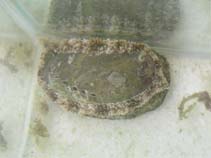Haliotis asinina Linnaeus, 1758
Donkey's ear abalone| Native range | All suitable habitat | Point map | Year 2050 |

|
| This map was computer-generated and has not yet been reviewed. |
| Haliotis asinina AquaMaps Data sources: GBIF OBIS |
Classification / Names প্রচলিত নাম সমূহ | প্রতিনাম সমূহ | CoL | ITIS | WoRMS
Gastropoda | Lepetellida | Haliotidae
Environment: milieu / climate zone / গভীরতার পরিসীমা / distribution range বাস্তুসংস্থান
; গভীরতার পরিসীমা 0 - 10 m (সূত্র 349). Tropical
Distribution দেশ সমূহ | এফ এ ও এলাকাসমূহ | বাস্তুতন্ত্র | দৃষ্টিগোচর | প্রচলন
Indo-West Pacific.
Length at first maturity / আকৃতি / Weight / Age
পরিপক্কতা : Lm ?, range 4 - ? cm Max length : 12.0 cm ShH পুরুষ/ লিঙ্গ অনিধর্ারিত ; (সূত্র 349); common length : 9.0 cm SHL পুরুষ/ লিঙ্গ অনিধর্ারিত ; (সূত্র 349)
Short description বহিঃ অঙ্গ সংস্থান
The shell is thin, elongate-ovate in outline with slightly protruding spire. Outer lip slightly sinuous in the middle. Outer surface almost smooth. Holes ovate, nearly flush with surafce of shell, the last 5 to 7 holes open. Colouration: Shell shiny, olive green or brown, with several triangular patches of pale green or cream. Inside of shell highly iridescent (Ref. 128042).
Actively collected in the Southeast Asian countries, for its shell and large fleshy animal (Ref. 349). Found in intertidal, on corals (Refs. 75835, 128042). Common, but not aggregating in dense populations. In life, the exceptionally large green mantle almost covers the shell, which is then devoid of encrusting marine growths, unlike those of the other species (Ref. 349). Very active at night (Ref. 799). Feeds on epilithic algae by grazing (Ref. 85382).
Life cycle and mating behavior পরিপক্কতা | প্রজনন | ডিম ছাড়া | Eggs | ডিম্বধারন ক্ষমতা | Larvae
Members of the order Patellogastropoda are mostly gonochoric and broadcast spawners. Life cycle: Embryos develop into planktonic trocophore larvae and later into juvenile veligers before becoming fully grown adults.
Main reference
সূত্র সংখ্যা | সমম্বয়কারী | সহযোগী
Poutiers, J.M. 1998. (সূত্র 349)
IUCN Red List Status
(সূত্র 130435: Version 2024-2)
Least Concern (LC) ; Date assessed: 19 September 2020
CITES status (সূত্র 108899)
Not Evaluated
CMS (সূত্র 116361)
Not Evaluated
Threat to humans
Human uses
মৎস্য: বাণিজ্যিক
| FishSource |
হাতিয়ার
আরো তথ্য
ট্রফিক বাস্তুতন্ত্র
বাস্তুসংস্থান
Population dynamics
বৃদ্ধি
Max. ages / sizes
Length-weight rel.
Length-length rel.
Length-frequencies
Mass conversion
নির্বাচন
প্রাচুর্য
Max. ages / sizes
Length-weight rel.
Length-length rel.
Length-frequencies
Mass conversion
নির্বাচন
প্রাচুর্য
Life cycle
Distribution
Human Related
Aquaculture profiles
Stamps, coins, misc.
Stamps, coins, misc.
Outreach
সূত্র সংখ্যা
ইন্টারনেট সুত্র
BHL | BOLD Systems | CISTI | DiscoverLife | FAO(Publication : search) | Fishipedia | GenBank (genome, nucleotide) | GloBI | Gomexsi | Google Books | Google Scholar | Google | PubMed | জীবন বৃক্ষ | Wikipedia (Go, অনুসন্ধান ) | জুলজিকাল রেকর্ড
Estimates based on models
Preferred temperature
(Ref. 115969): 24.3 - 29.3, mean 28.6 (based on 2643 cells).



